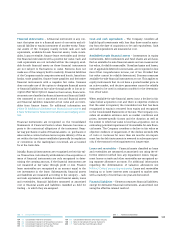Siemens 2011 Annual Report Download - page 272
Download and view the complete annual report
Please find page 272 of the 2011 Siemens annual report below. You can navigate through the pages in the report by either clicking on the pages listed below, or by using the keyword search tool below to find specific information within the annual report.
6 A. To our shareholders 51 C. Combined management’s discussion and analysis 23 B. Corporate Governance
IFRS provides guidance for the accounting of joint arrange-
ments by focusing on the rights and obligations of the ar-
rangement, rather than its legal form. IFRS classifies joint
arrangements into two types – joint operations and joint ven-
tures: A joint operation is a joint arrangement whereby the
parties that have joint control of the arrangement (i.e. joint
operators) have rights to the assets, and obligations for the li-
abilities, relating to the arrangement. A joint venture is a joint
arrangement whereby the parties that have joint control of
the arrangement (i.e. joint venturers) have rights to the net
assets of the arrangement. IFRS requires a joint operator to
recognize and measure the assets and liabilities (and recog-
nize the related revenues and expenses) in relation to its in-
terest in the arrangement applicable to the particular assets,
liabilities, revenues and expenses. A joint venturer is required
to recognize an investment and to account for that invest-
ment using the equity method.
IFRS is a new and comprehensive standard on disclosure re-
quirements for all forms of interests in other entities, includ-
ing joint arrangements, associates, structured entities and off
balance sheet vehicles. The standard requires an entity to dis-
close information that enables users of financial statements
to evaluate the nature of, and risks associated with, its inter-
ests in other entities and the effects of those interests on its
financial position, financial performance and cash flows.
IAS (amended ) now only contains requirements relat-
ing to separate financial statements as a result of the issuance
of the new standard IFRS .
According to the amendment of IAS an entity shall account
for an investment, or a portion of an investment, in an associ-
ate or a joint venture as held for sale if it meets the relevant
criteria. Any retained portion of an investment in an associate
or a joint venture that has not been classified as held for sale
shall be accounted for using the equity method until disposal
of the portion that is classified as held for sale takes place.
IFRS , , and the consequential amendments to IAS
and IAS are effective for annual periods beginning on or af-
ter January , . These new or amended standards may be
adopted early, but must be adopted as a package, that is, all as
of the same date, except that an entity may early adopt the
disclosure provisions for IFRS (without adopting the other
new standards). The standards are to be applied on a retro-
spective basis. IFRS , , , and the consequential amend-
ments to IAS and IAS are not endorsed by the European
Union yet. The Company is currently assessing the impact of
the adoption on the Company ’s Consolidated Financial State-
ments and will determine an adoption date.
In May , the IASB issued IFRS , Fair Value Measurement.
The new standard does not determine if a fair value measure-
ment is applicable for certain assets and liabilities, but merely
defines fair value and standardizes disclosure requirements
for fair value measurements. The new standard is applicable
for annual periods beginning on or after January , ; early
adoption is permitted. IFRS is not endorsed by the Europe-
an Union yet. Regarding financial instruments, the majority of
changes required by IFRS have already been introduced,
mainly by amendments to IFRS , Financial Instruments: Dis-
closures. Hence, only a minor impact is expected for financial
assets and financial liabilities. The Company is currently as-
sessing the impact of the adoption concerning non-financial
assets and liabilities on the Company ’s Consolidated Financial
Statements and will determine an adoption date.
In October , the IASB issued amendments to IFRS , Fi-
nancial Instruments: Disclosures, which enhance the disclo-
sure requirements, hence maintain the derecognition model
of IAS . The amendments increase the disclosure require-
ments for transfers of financial assets where the transferor re-
tains continuing involvement in the transferred asset; addi-
tional disclosures are required if a disproportionate amount of
transfer transactions are undertaken around the end of a re-
porting period. The amendment is applicable for annual re-
porting periods beginning on or after July , ; early adop-
tion is permitted. The Company expects no material impact on
the Company ’s Consolidated Financial Statements as a result
of adopting the amendment.
In November , the IASB issued IFRS , Financial Instru-
ments. This standard is the first phase of the IASB’s three-
phase project to replace IAS , Financial Instruments: Recog-
nition and Measurement. IFRS amends the classification
and measurement requirements for financial assets, including
some hybrid contracts. It uses a single approach to determine
whether a financial asset is measured at amortized cost or at
fair value, replacing the different rules in IAS . The ap-
proach in IFRS is based on how an entity manages its finan-
cial instruments (its business model) and the contractual
cash flow characteristics of the financial assets. The new stan-
dard also requires a single impairment method to be used, re-
placing the different impairment methods in IAS . The new
standard is still applicable for annual reporting periods begin-
























